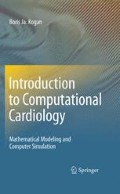Abstract
Normal heart function is directly connected with periodic propagation of excitation waves initiated by the pacemaker heart system. Electrophysiological experiments show that distortions in heart rhythm such as tachycardia are a precursor to ventricular fibrillation (see Fig. 5A and 5B in Chapter 1, Introduction). Ventricular fibrillation may occur in either already damaged or initially healthy hearts. The mechanisms of ventricular fibrillation are not fully understood. In current literature [1], monomorphic tachycardia is associated with stationary propagation of spiral excitation waves, while polymorphic tachycardia is thought to be due to nonstationary propagation. The breakup of a wavefront of a non-stationary propagating spiral wave obtained in computer simulation with tissue formed of AP models without Ca dynamics is considered fibrillation [2]. Spiral waves were discovered during computer simulations [3]. Their existence was confirmed, years later, in the course of physiological experiments [4] in 2D normal atrium cardiac tissue by properly applied premature stimulation.
Access this chapter
Tax calculation will be finalised at checkout
Purchases are for personal use only
Preview
Unable to display preview. Download preview PDF.
References
Winfree, A.T., Mechanisms of cardiac fibrillation - Reply. Science, 1995. 270: 1224–1225.
Karma, A., Electrical alternans and spiral wave breakup in cardiac tissue. Chaos, 1994. 4: 461–472.
Gulko, F.B. and A.A. Petrov, Mechanisms of the formation of closed pathways of conduction in excitable media. Biofizika (USSR), 1972. 17: 261–270.
Allessie, M.A., F.I.M. Bonke, and F.J.C. Schopman, Circus movement in rabbit atrial muscle as a mechanism of tachycardia. Circ.Res., 1973. 33: 54–77.
Zykov, V.S., Simulation of Wave Process in Excitable Media. Nonlinear science: theory and applications, ed. A.V. Holden. 1987, Manchester and New York: Manchester University Press.
Tyson, J.J. and J.P. Keener, Singular perturbation theory of traveling waves in excitable media. Physica D, 1988. 32: 327–361.
Keener, J.P. and A.V. Panfilov, The effects of geometry and fibre orientation on propagation and extracellular potentials in myocardium, in Computational Biology of the Heart, A.V. Panfilov and J.P. Keener, Editors. 1997, John Wiley & Sons: New York, NY. p. 235–258.
Henriquez, C.S., Simulating the electrical behavior of cardiac tissue using the bidomain model. Crit Rev Biomed Eng, 1993. 21: 1–77.
Neu, J.C. and W. Krassowska, Homogenization of syncytial tissues. Crit Rev Biomed Eng, 1993. 21: 137–199.
Roth, B.J., How the anisotropy of the intracellular and extracellular conductivities influences stimulation of cardiac muscle. J Math Biol, 1992. 30: 633–646.
Luo, C.H. and Y. Rudy, A dynamic model of the cardiac ventricular action potential. I. Simulations of ionic currents and concentration changes. Circ Res, 1994. 74: 1071–1096.
Chudin, E., J. Goldhaber, A. Garfinkel, J. Weiss, and B. Kogan, Intracellular Ca(2+) dynamics and the stability of ventricular tachycardia. Biophys J, 1999. 77: 2930–2941.
Huffaker, R.B., R. Samade, J.N. Weiss, and B. Kogan, Tachycardia-induced early afterdepolarizations: Insights into potential ionic mechanisms from computer simulations. Comput Biol Med, 2008. 38: 1140–1151.
Rudy, Y. and W. Quan, A model study of the effects of the discrete cellular structure on electrical propagation in cardiac tissue. Circ.Res., 1987. 61: 815–823.
Leon, L.J., F.A. Roberge, and A. Vinet, Simulation of two-dimensional anisotropic cardiac reentry: effects of the wavelength on the reentry characteristics. Ann Biomed Eng, 1994. 22: 592–609.
Leon, L.J. and F.A. Roberge, Structural complexity effects on transverse propagation in a two-dimensional model of myocardium. IEEE Trans Biomed Eng, 1991. 38: 997–1009.
Drouhard, J.P. and F.A. Roberge, Revised formulation of the Hodgkin-Huxley representation of the sodium current in cardiac cells. Comput Biomed Res, 1987. 20: 333–350.
Gulko, F.B. and A.A. Petrov, On a mathematical model of excitation processes in the Purkinje fiber. Biofizika (USSR), 1970. 15: 513–520.
Kogan, B. and P. Vrbavatz, General structure of the hybrid computer system HCS-100. 1974, Moscow Institute of Control Science: Moscow, Russia.
Wiener, N. and A. Rosenblueth, The mathematical formulation of the problem of conduction of impulses in a network of connected excitable elements, specifically in cardiac muscle. Arch. Inst. Cardiol. Mexico, 1946. 16: 205–265.
Kogan, B.Y., W.J. Karplus, B.S. Billet, A.T. Pang, H.S. Karagueuzian, and S.S. Khan, The simplified Fitzhugh-Nagumo model with action potential duration restitution: effects on 2D-wave propagation. Physica D, 1991. 50: 327–340.
Fife, P.C., Mathematical Aspects of Reacting and Diffusing Systems. 1979, Berlin, Germany: Springer-Verlag.
Keener, J.P., An eikonal-curvature equation for action potential propagation in myocardium. J Math Biol, 1991. 29: 629–651.
Kogan, B.Y., W.J. Karplus, B.S. Billet, and W. Stevenson, Excitation wave propagation within narrow pathways: geometric configurations facilitating unidirectional block and reentry. Physica D, 1992. 59: 275–296.
Author information
Authors and Affiliations
Corresponding author
Rights and permissions
Copyright information
© 2010 Springer Science+Business Media, LLC
About this chapter
Cite this chapter
Kogan, B.J. (2010). Waves in Two Dimensional Models of Myocardium. In: Introduction to Computational Cardiology. Springer, Boston, MA. https://doi.org/10.1007/978-0-387-76686-7_8
Download citation
DOI: https://doi.org/10.1007/978-0-387-76686-7_8
Published:
Publisher Name: Springer, Boston, MA
Print ISBN: 978-0-387-76685-0
Online ISBN: 978-0-387-76686-7
eBook Packages: Computer ScienceComputer Science (R0)

